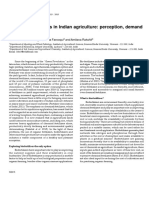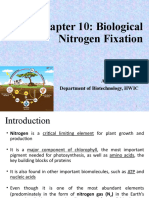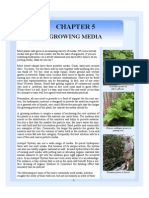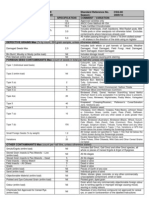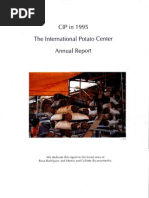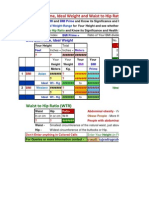Bio Fertilizer
Bio Fertilizer
Uploaded by
Divyesh ButalaCopyright:
Available Formats
Bio Fertilizer
Bio Fertilizer
Uploaded by
Divyesh ButalaCopyright
Available Formats
Share this document
Did you find this document useful?
Is this content inappropriate?
Copyright:
Available Formats
Bio Fertilizer
Bio Fertilizer
Uploaded by
Divyesh ButalaCopyright:
Available Formats
Management of Agri-Inputs
DIVYESH
2012
Bio-fertilizer
Amity Institute of Organic Agriculture Butala Divyesh AnilBhai A1403110002 MBA Agri & Food Business
Bio-fertilizer
Introduction:A bio-fertilizer is a substance which contains living microorganisms which, when applied to seed, plant surfaces, or soil, colonizes the rhizosphere or the interior of the plant and promotes growth by increasing the supply or availability of primary nutrients to the host plant. Bio-fertilizers add nutrients through the natural processes of nitrogen fixation, solubilising phosphorus, and stimulating plant growth through the synthesis of growthpromoting substances. Bio-fertilizers can be expected to reduce the use of chemical fertilizers and pesticides. The microorganisms in bio-fertilizers restore the soil's natural nutrient cycle and build soil organic matter. Through the use of bio-fertilizers, healthy plants can be grown, while enhancing the sustainability and the health of the soil. Since they play several roles, a preferred scientific term for such beneficial bacteria is "plant-growth promoting rhizobacteria" (PGPR). Therefore, they are extremely advantageous in enriching soil fertility and fulfilling plant nutrient requirements by supplying the organic nutrients through microorganism and their by-products. Hence, bio-fertilizers do not contain any chemicals which are harmful to the living soil. Bio-fertilizers are eco-friendly organic agro-input and more cost-effective than chemical fertilizers. Bio-fertilizers such as Rhizobium, Azotobacter, Azospirillum and blue green algae (BGA) have been in use a long time. Rhizobiuminoculant is used for leguminous crops. Azotobacter can be used with crops like wheat, maize, mustard, cotton, potato and other vegetable crops. Azospirillum inoculations are recommended mainly for sorghum, millets,maize, sugarcane and wheat. Blue green algae belonging to a generalcyanobacteria genus, Nostoc or Anabaena or Tolypothrix or Aulosira, fix atmospheric nitrogen and are used as inoculations for paddy crop grown both under upland and low-land conditions. Anabaena in association with water fern Azolla contributes nitrogen up to 60 kg/ha/season and also enriches soils with organic matter. Other types of bacteria, so-called phosphate-solubilising bacteria, such as Pantoea agglomerans strain P5 or Pseudomonas putida strain P13, are able to solubilize the insoluble phosphate from organic and inorganic phosphatesources. In fact, due to immobilization of phosphate by mineral ions such asFe, Al and Ca or organic acids, the rate of available phosphate (Pi) in soil is well below plant needs. In addition, chemical Pi fertilizers are also immobilized in the soil, immediately, so that less than 20 percent of added fertilizer is absorbed by plants. Therefore, reduction in Pi resources, on one hand, and environmental pollutions resulting from both production and applications of chemical Pi fertilizer, on the other hand, have already demanded the use of new generation of phosphate fertilizers globally known as phosphate-solubilizing bacteria or phosphate bio-fertilizers.
Bio-fertilizer
Govt Scheme Title Types Objectives National Project on Development and Use of Bio fertilizers Central Sector Scheme Production and distribution of Bio fertilizers (BFs) Develop Standards for different BFs and Quality control Release of grants for setting up BF units Training and Publicity Under this scheme the Government provides non-recurring grants-in-aid up to Rs.20.00 lakhs for setting up bio fertilizer production units of 150 MT capacities. The grant-in-aid is offered to State Departments of Agriculture/cooperatives/public sector undertakings of fertilisers, NGOs and private agencies provided their proposals are received from respective State Governments. One time grant-in-aid to the extent of Rs.1.50 lakhs is provided for establishment of Blue-green algae sub-centre to produce 3040 tonnes of BGA/annum provided their proposals are received from respective State Governments This scheme is being implemented in the country with the help of a National and 6 Regional centres for training, field demonstration and its promotion and also through Department of Agriculture & Cooperation i.e. release of one time grant-inaid for setting up BF units.
Salient features
Major Players in India: (2006-2007) No. 1. 2. 3. 4. 5. 6. 7. Company KRIBHCO IFFCO NFL MFL FACT RCF BVFCL Capacity (MT) 550.00 240.00 100.00 100.00 150.00 150.00 30.00 Production (MT) 737.8 394.27 165.39 228.21 3.91 105.00 7.06
Bio-fertilizer
SWOT Analysis: Strength Weakness Abundant source of microorganisms. Apart from major players all Cos are small and middle size Well established fermentation industry enterprises, little capital. foundation in India. Most farmers need to be educated. Fertilizer most widely used material, stable demand in domestic and Should strengthen application and overseas markets. protection of pathogenic fungi patents. Opportunity Threat Development of organic agriculture Substandard and fake products in and environmental protection concept the market, affecting credibility of on the rise in many nations. bio fertilizer. Strategic alliances, integrating bio Imported agriculture products fertilizer and pesticide industry, go affect production of domestic into product diversification and agriculture products, easily reduce costs. manipulated by multinational Cos The pathogenic fungi developed domestically are better adapted than the pathogenic fungi from the cold regions of Europe and North America, which can be promoted into the Southeast Asian and China markets. Current development bottlenecks 1. Industry bottlenecks Difficult to find talent within the industry, lack of research talent. Quality of products inconsistent, quality unstable. Besides farmers in high economic value crop areas, ordinary farmers lack knowledge of application. Small scale of manufacturers with no R&D ability. 2. Technical bottlenecks The preservation and stability technology for biofertilizer product's additives needs to be improved. Product's multifunction needs to be improved. Pathogenic fungi product's adaptability toward the environment and crops needs to be enforced. References
http://fert.nic.in/production/bio_fertilizers.asp http://en.wikipedia.org/wiki/Biofertilizer http://agro.indiamart.com/agro-programme-schemes/fertiliser1.html http://www.imdr.edu/marketing_of_biofertilizers.html
You might also like
- Practice Test Grade 8 + Answer KeyDocument6 pagesPractice Test Grade 8 + Answer KeyRichardNo ratings yet
- Language Hub Placement Test With KeyDocument3 pagesLanguage Hub Placement Test With KeyKatherine Cruz100% (1)
- Summer Internship Project: Supply Chain & Marketing System of IffcoDocument13 pagesSummer Internship Project: Supply Chain & Marketing System of IffcoPawanLUMBANo ratings yet
- Why Is Roguing ImportantDocument1 pageWhy Is Roguing Importantpapotchi patototNo ratings yet
- Bio FertilizersDocument7 pagesBio Fertilizersrockingtwo07No ratings yet
- Master's Seminar On: Vermicompost As A Business ModelDocument28 pagesMaster's Seminar On: Vermicompost As A Business ModelRahul Kumar SinghNo ratings yet
- Compendium on Micronutrient Fertilisers in India Crop Response & Impact, Recent Advances and Industry TrendsFrom EverandCompendium on Micronutrient Fertilisers in India Crop Response & Impact, Recent Advances and Industry TrendsNo ratings yet
- Biofertilizers A Nexus Between Soil FertilityDocument14 pagesBiofertilizers A Nexus Between Soil FertilityMAURICIO ALFONSO AGUILERA OSORIONo ratings yet
- Biofertilizers A Potential Approach For Sustainable Agriculture Development PDFDocument21 pagesBiofertilizers A Potential Approach For Sustainable Agriculture Development PDFAzriah AsisNo ratings yet
- Various Types of Bio FertilizersDocument3 pagesVarious Types of Bio FertilizersSreenivv100% (1)
- Crop Protection ManagementDocument17 pagesCrop Protection ManagementArpita SonawaneNo ratings yet
- Scope and Imp. of MushroomDocument10 pagesScope and Imp. of MushroomRasmi RanjanNo ratings yet
- Fermentation of Liquid BiofertilizersDocument5 pagesFermentation of Liquid BiofertilizersBrij Mohan SinghNo ratings yet
- Liquid Biofertilizers Boon For FarmersDocument6 pagesLiquid Biofertilizers Boon For FarmersWISDOM LIFESCIENCESNo ratings yet
- Conservation AgricultureDocument70 pagesConservation Agriculturechitrasharma28121999100% (1)
- An Assignment On BiofertilizersDocument8 pagesAn Assignment On BiofertilizerskumarNo ratings yet
- Hydroponics TechnologyDocument19 pagesHydroponics TechnologyfrlkhldNo ratings yet
- Herbicide Resistance in PlantsDocument198 pagesHerbicide Resistance in Plantsvarsha CRNo ratings yet
- Effect of Vermicompost Prepared From Aquatic Weeds On Growth and Yield of Eggplant Solanum Melongena L 2155 6202.10000128Document5 pagesEffect of Vermicompost Prepared From Aquatic Weeds On Growth and Yield of Eggplant Solanum Melongena L 2155 6202.10000128josephNo ratings yet
- Fungal Biofertilizers in Indian Agriculture: Perception, Demand and PromotionDocument13 pagesFungal Biofertilizers in Indian Agriculture: Perception, Demand and PromotionJeimy MaciasNo ratings yet
- Prospects of Biofertilizers by Raj VakilDocument16 pagesProspects of Biofertilizers by Raj VakilRaj VakilNo ratings yet
- Additives: Organically Sourced MicronutrientsDocument4 pagesAdditives: Organically Sourced MicronutrientsPercy CoraNo ratings yet
- Chapter 10 Biological Nitrogen FixationDocument33 pagesChapter 10 Biological Nitrogen Fixationrajiv pathakNo ratings yet
- Advances in Blueberry Vaccinium SPP in Vitro CultuDocument21 pagesAdvances in Blueberry Vaccinium SPP in Vitro CultuRaluca-Cristina GuriencuNo ratings yet
- Agroecological InnovationsDocument321 pagesAgroecological InnovationshistorymakeoverNo ratings yet
- Agricultural Science Work.Document15 pagesAgricultural Science Work.Isabella persad100% (1)
- General Microbiology Laboratory Manual: Biology 490Document83 pagesGeneral Microbiology Laboratory Manual: Biology 490Ibnul MubarokNo ratings yet
- Lipase Applications in Food IndustryDocument19 pagesLipase Applications in Food IndustryKomagatae Xylinus100% (1)
- Storage of Grain and SeedDocument9 pagesStorage of Grain and SeedMuniswamaiah MohanNo ratings yet
- Projects in Indian Biodiesel Corporation LTDDocument7 pagesProjects in Indian Biodiesel Corporation LTDSachin KhotNo ratings yet
- Effect of Different Agro-Wastes, Casing Materials and Supplements On The Growth, Yield and Nutrition of Milky MushroomDocument11 pagesEffect of Different Agro-Wastes, Casing Materials and Supplements On The Growth, Yield and Nutrition of Milky MushroomHà BrunyNo ratings yet
- Biofertilizers and NanofertilizersDocument17 pagesBiofertilizers and NanofertilizersCamilla EmanuellaNo ratings yet
- Aeroponics: An Alternative Production System For High-Value Root CropsDocument8 pagesAeroponics: An Alternative Production System For High-Value Root CropsAlfatehan SeptiantaNo ratings yet
- PMKSY - Micro Irrigation Drip System in Paddy By: Tmt. J.Vijaya Rani I.A.S Additional Director of Agriculture (PM)Document14 pagesPMKSY - Micro Irrigation Drip System in Paddy By: Tmt. J.Vijaya Rani I.A.S Additional Director of Agriculture (PM)ramoo.csaNo ratings yet
- Organic-Approved PesticidesDocument6 pagesOrganic-Approved PesticidesSchool Vegetable GardeningNo ratings yet
- Course Reader Week 1Document21 pagesCourse Reader Week 1pirateNo ratings yet
- Use of Bio. Fertilizers in Crop Production and Soil Fertility in Ut of Jammu and Kashmir (India)Document6 pagesUse of Bio. Fertilizers in Crop Production and Soil Fertility in Ut of Jammu and Kashmir (India)IJAR JOURNALNo ratings yet
- VermicultureDocument11 pagesVermiculturevipulsingh161No ratings yet
- Bio-FIT Book ENDocument256 pagesBio-FIT Book ENCesar Augusto Colorado RamirezNo ratings yet
- Green House and Poly House Technology Raising Trend in Commercial AgricultureDocument8 pagesGreen House and Poly House Technology Raising Trend in Commercial Agricultureshubham appNo ratings yet
- Model ProjectDocument93 pagesModel Projectgowri2703No ratings yet
- Biofertilizer TDocument18 pagesBiofertilizer Tsd100% (1)
- UA Unit 1Document16 pagesUA Unit 1jobinrs22022No ratings yet
- Book Chapter NanoparticlesDocument21 pagesBook Chapter NanoparticlesDr-Ad SumraNo ratings yet
- Liquid Bio FertilizersDocument1 pageLiquid Bio FertilizersPrakash VaghasiyaNo ratings yet
- 1500a1550 - Dr. Stephen G. DiverDocument67 pages1500a1550 - Dr. Stephen G. Diverduga11100% (1)
- Curry Leaves Farming Guide Curry Leaf CultivationDocument2 pagesCurry Leaves Farming Guide Curry Leaf CultivationMoolam RaoNo ratings yet
- (23279834 - HortScience) Ammonium and Nitrate Accumulation in Containerized Southern Highbush Blueberry PlantsDocument4 pages(23279834 - HortScience) Ammonium and Nitrate Accumulation in Containerized Southern Highbush Blueberry PlantsFiorella EspinozaNo ratings yet
- Hydroponics Made Easy - Chapter 5 - Pdfa PDFDocument3 pagesHydroponics Made Easy - Chapter 5 - Pdfa PDFChiêm Nguyễn Anh VũNo ratings yet
- Bio FertilizersDocument48 pagesBio FertilizerssdNo ratings yet
- Chapter 1 - Introduction Definition and Classification of NutrientsDocument3 pagesChapter 1 - Introduction Definition and Classification of NutrientsDaniele ReisNo ratings yet
- PFALs OrsiniDocument124 pagesPFALs OrsiniMIRK95No ratings yet
- Chemistry of FertilizersDocument75 pagesChemistry of FertilizersAgStar CordinationNo ratings yet
- NitrogenDocument19 pagesNitrogenKayıtsız ŞartsızNo ratings yet
- Ifs Ssrana PchopraDocument100 pagesIfs Ssrana PchopraHarini anuNo ratings yet
- Vermicompost Significantly Affects Plant Growth. A Meta-AnalysisDocument15 pagesVermicompost Significantly Affects Plant Growth. A Meta-AnalysisRIZALYN RESULTAYNo ratings yet
- PAT 401 Diseases of Horticultural Crops 2020-RevisedDocument175 pagesPAT 401 Diseases of Horticultural Crops 2020-RevisedAarzoo JainNo ratings yet
- Arbuscular Mycorrhizal Fertilizer Powder Formulation (Glomus Mosseae) As Bio Fertilizer Raw MaterialsDocument5 pagesArbuscular Mycorrhizal Fertilizer Powder Formulation (Glomus Mosseae) As Bio Fertilizer Raw MaterialsInternational Journal of Innovative Science and Research TechnologyNo ratings yet
- CSG 60 Cereal Rye 200910 FinalDocument1 pageCSG 60 Cereal Rye 200910 FinalwsocNo ratings yet
- Leaf Color Chart Version 1.2Document3 pagesLeaf Color Chart Version 1.2Maribel NimoNo ratings yet
- Poultry Plan EditDocument24 pagesPoultry Plan EditOnyinyechi Emereole Ononiba100% (1)
- Tong Hop de Thi TaDocument55 pagesTong Hop de Thi TaTuNo ratings yet
- Food Spoilage PPT 711c4Document17 pagesFood Spoilage PPT 711c4ayanakhter149209No ratings yet
- HSK5 - NounDocument166 pagesHSK5 - NounThanh Huyềb TrầnNo ratings yet
- Dr. Marty Pets Dog and Cat Food Premium Freeze Dried Raw Pet Food 4Document1 pageDr. Marty Pets Dog and Cat Food Premium Freeze Dried Raw Pet Food 4Ben AllenNo ratings yet
- CIP Annual Report 1995Document56 pagesCIP Annual Report 1995cip-libraryNo ratings yet
- st6 Gram U10Document3 pagesst6 Gram U10mitziNo ratings yet
- Parabolic Solar CookersDocument5 pagesParabolic Solar CookersTsaousisGiannisNo ratings yet
- Bagre PangasiusDocument25 pagesBagre PangasiusPaola Abello RamirezNo ratings yet
- Diversity Lesson PlanDocument2 pagesDiversity Lesson Planapi-524300540No ratings yet
- Conjunction Definition, Types, Meaning, and Conjunction Examples in English GrammarDocument6 pagesConjunction Definition, Types, Meaning, and Conjunction Examples in English GrammarSujan AcharyaNo ratings yet
- Elementary December Lunch Menu 2014Document1 pageElementary December Lunch Menu 2014VogeleiWoodNo ratings yet
- Snickerdoodle Cookie Recipe Live Craft EatDocument6 pagesSnickerdoodle Cookie Recipe Live Craft EatRebecka PrinzNo ratings yet
- Lesson 2 Environment and ECOLOGY Part 5Document25 pagesLesson 2 Environment and ECOLOGY Part 5Ma. Angelyka AbuboNo ratings yet
- BMI & Other Health Calculators-EDocument4 pagesBMI & Other Health Calculators-ERajendra PrabhuneNo ratings yet
- Interview QuestionsDocument2 pagesInterview QuestionsMuiz MaulanaNo ratings yet
- Primary Group Activities I Healthy: Inside and Out I Children's Mental Health Week (4-10 Feb 2019)Document2 pagesPrimary Group Activities I Healthy: Inside and Out I Children's Mental Health Week (4-10 Feb 2019)Raquel Serrano GarcíaNo ratings yet
- The Art of Eating Smart: The Five Major Food GroupsDocument4 pagesThe Art of Eating Smart: The Five Major Food Groupscecilia_mckikayNo ratings yet
- Modulo 7 Ingles 5Document34 pagesModulo 7 Ingles 5Hongito andanteNo ratings yet
- Subject Verb TestDocument2 pagesSubject Verb TestNguyen Thi HoaNo ratings yet
- Anusha Catelogue - Updated PriceDocument19 pagesAnusha Catelogue - Updated PriceRuthvic GowdaNo ratings yet
- Afrincan LionDocument106 pagesAfrincan LionCamilo0330No ratings yet
- Bài tập bổ trợ tuần 6 -TVNPDocument7 pagesBài tập bổ trợ tuần 6 -TVNPPHĐ Phạm Hồng ĐứcNo ratings yet
- Uni Source Lodging Product Guide 2012Document234 pagesUni Source Lodging Product Guide 2012Travis BattingNo ratings yet
- Too Much Many Too Adjective Exercises With AkDocument2 pagesToo Much Many Too Adjective Exercises With Akapi-520203796No ratings yet






















